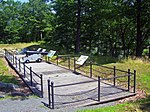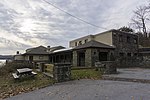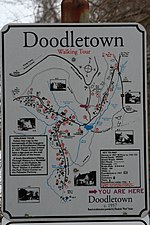Bear Mountain Bridge

The Bear Mountain Bridge, ceremonially named the Purple Heart Veterans Memorial Bridge, is a toll suspension bridge in New York State. It carries US 6 and US 202 across the Hudson River between Bear Mountain State Park in Orange County and Cortlandt in Westchester County. At completion in 1924 it was longest suspension bridge in the world until this record was surpassed 19 months later by the Benjamin Franklin Bridge between Philadelphia and Camden, New Jersey. The Bear Mountain Bridge is unconventional among suspension bridges: though its main span (between the towers) is suspended by cables in the usual manner, the approach spans (outside the towers) do not have suspender cables and are instead unsuspended trusses, like the Williamsburg Bridge in New York City. The span enables connections between the Palisades Interstate Parkway and US 9W on the west bank near Bear Mountain and NY 9D on the east bank as well as US 9 and the Bear Mountain Parkway farther east. It also carries the Appalachian Trail and New York State Bicycle Route 9 across the Hudson. The bridge has two undivided vehicle lanes flanked by sidewalks. Cyclists may ride with motor vehicle traffic or walk their bikes on the sidewalks.
Excerpt from the Wikipedia article Bear Mountain Bridge (License: CC BY-SA 3.0, Authors, Images).Bear Mountain Bridge
Πανός, Athen
Geographical coordinates (GPS) Address Nearby Places Show on map
Geographical coordinates (GPS)
| Latitude | Longitude |
|---|---|
| N 41.32 ° | E -73.980277777778 ° |
Address
Ρωμαϊκή Αγορά Αθηνών
Πανός
105 55 Athen (1η Κοινότητα Αθηνών)
Attika, Griechenland
Open on Google Maps










